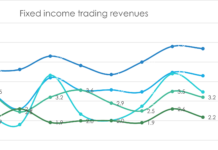US Treasury issuance was estimated to be almost US$4 trillion across 2023 and Q1 2024, a 305.7% increase on the historical average, with Treasuries outstanding set at US$26.4 trillion.
Total issuance in 2023 was US$8.3 trillion, down 6.3% year-on-year (YoY). Average daily volumes (ADV) stood at US$1.1 trillion in 2023, up 9% YoY. US Treasury issuance in 2023 alone was US$3.5 trillion, down 8.1% YoY but ADV was up 11$, to US$760.5 billion. Corporate bond issuance in 2023 stood at $1.4 trillion, a +5.4% increase YoY. ADV stood at $42.5 billion, up 6.6% YoY. Munis issuance in 2023 stood at US$380.5 billion, down 2.6% YoY. ADV stood at US$13.2 billion, down 5.7% YoY.
In 2023 investment grade electronic trading accounted for 42% of notional volume, with high yield making up 30% of total volume.
The findings come in a new report from the Securities Industry and Financial Markets Association (SIFMA), which studied key trends in fixed income markets in 2023.
The report also found that the Federal Reserve constituted 18.1% of Treasury holders, with foreign reserves holding 31.2% and the top two, Japan and China, now selling. Demand is now taken up by asset managers and hedge funds, which are price sensitive, the report noted.

Kevin McPartland, head of market structure and technology research at Coalition Greenwich, said, “The shift [in US Treasuries] we’ve seen over the last three to four years is electronic trading is increasingly done between dealers and clients. We now have dealer and client each trading now over 60%.
“On the corporate bond side, we have seen a very strong growth story over the last ten years from an electronic trading perspective. 2023 investment grade electronic trading accounted for 42% of notional volume versus low teens a decade ago; high yield 30% of total volume versus low single digits.”
Innovations in market structure have allowed the market to trade at such high volumes, the report noted, as well as wider macro uncertainty around the direction of the market.
“This is great because that’s what really makes active capital markets – you have people willing to be on both sides of every trade. I think those dynamics are definitely helping to keep these volumes as high as they’ve been,” McPartland added. Increased fiscal spending has also led to elevated levels of Treasury issuance.
In corporate bonds, at the end of 2022 after the US started to raise interest rates, volumes started to grow, the report noted. “It was less about the notional volumes and more about the average daily trade count, signifying a huge influx of retail interest in the bond market. From 2021 to 2022, the average daily trade count effectively doubled – hitting almost 100,000 trades a day – and growth continued in 2023. We were up another 20% from a trade count perspective in 2023, and, so far in 2024, the trend continues,” McPartland said.
©Markets Media Europe 2024
©Markets Media Europe 2025













